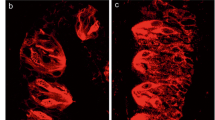Abstract
We could identify two types of K+ channels, of 80 and 40 pS conductance, respectively, in the bullfrog taste cell membrane using excised and cell-attached configurations of the patch-clamp technique. The taste cell membrane could be divided into four membrane parts — receptive area, apical process, cell body and proximal process. The 80-pS K+ channels were dependent on voltage and Ca2+ and were located exclusively on the receptive membrane and the apical process membrane. The 40-pS K+ channels were independent of voltage and Ca2+. The open probability of 40-pS K+ channels was decreased by the simultaneous presence of cyclic adenosine monophosphate (cAMP) and adenosine triphosphate (ATP), and the suppressive effect was antagonized by protein kinase inhibitor (PKI). Although 40-pS K+ channels were found in a high density on the receptive and apical process membranes, the channels also were present in the other two parts of the taste cell membrane. These results suggest that the two different types of K+ channel in the bullfrog taste cells may play different roles in gustatory transduction.
Similar content being viewed by others
References
Avenet P, Lindemann B (1988) Amiloride-blockable sodium current in isolated taste receptor cells. J Membr Biol 105: 245–255
Avenet P, Hofmann F, Lindemann B (1988) Transduction in taste receptor cells requires cAMP-dependent protein kinase. Nature 331: 351–354
Cummings T, Kinnamon SC (1992) Apical K+ channel in Necturus taste cells. Modulation by intracellular factors and taste stimuli. J Gen Physiol 99: 591–613
Davies NW, Standen NB, Stanfield PR (1992) The effect of intracellular pH on ATP-dependent potassium channels of frog skeletal muscle. J Physiol (Lond) 445: 549–568
DeHan RS, Graziadei PPC (1971) Functional anatomy of frog's taste organ. Experientia 27: 823–826
Fujiyama R, Miyamoto T, Sato T (1993) Non-selective cation channel in bullfrog taste cell membrane. Neuroreport 5: 11–13
Graziadei PPC, DeHan RS (1971) The ultrastructure of frog's taste organ. Acta Anat 80: 563–603
Hamill OP, Marty A, Neher E, Sakmann B, Sigworth FJ (1981) Improved patch-clamp techniques for high-resolution current recording from cells and cell-free membrane patches. Pflügers Arch 391: 85–100
Kaczmarek LK (1988) The regulation of neural calcium and potassium channels by protein phosphorylation. In: Greengard P, Robinson GA (eds) Advances in second messenger and phosphorylation research, vol 22. Raven Press, New York, pp 113–138
Kasai H, Petersen OH (1994) Spatial dynamics of second messengers: IP3 and cAMP as long-range and associative messengers. Trends Neurosci 17: 95–101
Kinnamon SC, Roper SD (1988) Membrane properties of isolated mudpuppy taste cells. J Gen Physiol 91: 351–371
Miyamoto T, Okada Y, Sato T (1988) Ionic basis of receptor potential of frog taste cells induced by acid stimuli. J Physiol (Lond) 405: 699–711
Miyamoto T, Okada Y, Sato T (1988) Membrane properties of isolated frog taste cells: three types of responsivity to electrical stimulation. Brain Res 449: 369–372
Miyamoto T, Okada Y, Sato T (1991) Voltage-gated membrane current of isolated bullfrog taste cells. Zool Sci 8: 835–845
Okada Y, Miyamoto T, Sato T (1994) Activation of a cation conductance by acetic acid in taste cells isolated from the bullfrog. J Exp Biol 187: 19–32
Okada Y, Miyamoto T, Sato T (1986) Contribution of the receptor and basolateral membranes to the resting potential of a frog taste cell. Jpn J Physiol 36: 139–150
Petersen OH, Petersen CC, Kasai H (1994) Calcium and hormone action. Annu Rev Physiol 56: 297–319
Roper SD, McBride DW Jr (1989) Distribution of ion channels on taste cells and its relationship to chemosensory transduction. J Membr Biol 109: 29–39
Simon SA, Holland VF, Benos DJ, Zampighi GA (1993) Transcellular and paracellular pathways in lingual epithelia and their influence in taste transduction. Microsc Res Tech 26: 196–208
Sugimoto K, Teeter JH (1990) Voltage-dependent ionic currents in taste receptor cells of the larval tiger salamander. J Gen Physiol 96: 809–834
Author information
Authors and Affiliations
Rights and permissions
About this article
Cite this article
Fujiyama, R., Miyamoto, T. & Sato, T. Differential distribution of two Ca2+-dependent and -independent K+ channels throughout receptive and basolateral membranes of bullfrog taste cells. Pflugers Arch. 429, 285–290 (1994). https://doi.org/10.1007/BF00374325
Received:
Revised:
Accepted:
Issue Date:
DOI: https://doi.org/10.1007/BF00374325




